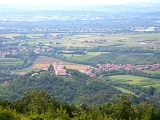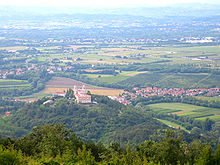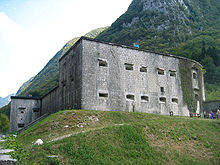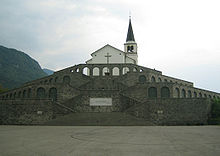
Battles of the Isonzo
Encyclopedia

Austria-Hungary
Austria-Hungary , more formally known as the Kingdoms and Lands Represented in the Imperial Council and the Lands of the Holy Hungarian Crown of Saint Stephen, was a constitutional monarchic union between the crowns of the Austrian Empire and the Kingdom of Hungary in...
and Italian
Italy
Italy , officially the Italian Republic languages]] under the European Charter for Regional or Minority Languages. In each of these, Italy's official name is as follows:;;;;;;;;), is a unitary parliamentary republic in South-Central Europe. To the north it borders France, Switzerland, Austria and...
armies in World War I
World War I
World War I , which was predominantly called the World War or the Great War from its occurrence until 1939, and the First World War or World War I thereafter, was a major war centred in Europe that began on 28 July 1914 and lasted until 11 November 1918...
. They were fought along the Soča
Soca
The Soča or Isonzo is a 140 km long river that flows through western Slovenia and northeastern Italy. An Alpine river in character, its source lies in the Trenta Valley in the Julian Alps in Slovenia, at an elevation of around 1,100 metres...
(Isonzo) River on the eastern sector of the Italian Front between June 1915 and November 1917(2 years long). Most of the battles were fought on the territory of modern Slovenia
Slovenia
Slovenia , officially the Republic of Slovenia , is a country in Central and Southeastern Europe touching the Alps and bordering the Mediterranean. Slovenia borders Italy to the west, Croatia to the south and east, Hungary to the northeast, and Austria to the north, and also has a small portion of...
, and the remainder in Italy
Italy
Italy , officially the Italian Republic languages]] under the European Charter for Regional or Minority Languages. In each of these, Italy's official name is as follows:;;;;;;;;), is a unitary parliamentary republic in South-Central Europe. To the north it borders France, Switzerland, Austria and...
.
During the First World War
World War I
World War I , which was predominantly called the World War or the Great War from its occurrence until 1939, and the First World War or World War I thereafter, was a major war centred in Europe that began on 28 July 1914 and lasted until 11 November 1918...
, the Soča
Soca
The Soča or Isonzo is a 140 km long river that flows through western Slovenia and northeastern Italy. An Alpine river in character, its source lies in the Trenta Valley in the Julian Alps in Slovenia, at an elevation of around 1,100 metres...
valley was part of the Alpine sector of the Italian Front
Italian Campaign (World War I)
The Italian campaign refers to a series of battles fought between the armies of Austria-Hungary and Italy, along with their allies, in northern Italy between 1915 and 1918. Italy hoped that by joining the countries of the Triple Entente against the Central Powers it would gain Cisalpine Tyrol , the...
, along which the armies of Italy
Italy
Italy , officially the Italian Republic languages]] under the European Charter for Regional or Minority Languages. In each of these, Italy's official name is as follows:;;;;;;;;), is a unitary parliamentary republic in South-Central Europe. To the north it borders France, Switzerland, Austria and...
and Austria-Hungary
Austria-Hungary
Austria-Hungary , more formally known as the Kingdoms and Lands Represented in the Imperial Council and the Lands of the Holy Hungarian Crown of Saint Stephen, was a constitutional monarchic union between the crowns of the Austrian Empire and the Kingdom of Hungary in...
clashed. It is known as the Isonzo Front by historians, but is usually translated as the Soška fronta by Slovenes.
Geographical location and strategic importance

Soca
The Soča or Isonzo is a 140 km long river that flows through western Slovenia and northeastern Italy. An Alpine river in character, its source lies in the Trenta Valley in the Julian Alps in Slovenia, at an elevation of around 1,100 metres...
(Isonzo) River is located in present-day Slovenia
Slovenia
Slovenia , officially the Republic of Slovenia , is a country in Central and Southeastern Europe touching the Alps and bordering the Mediterranean. Slovenia borders Italy to the west, Croatia to the south and east, Hungary to the northeast, and Austria to the north, and also has a small portion of...
and Italy
Italy
Italy , officially the Italian Republic languages]] under the European Charter for Regional or Minority Languages. In each of these, Italy's official name is as follows:;;;;;;;;), is a unitary parliamentary republic in South-Central Europe. To the north it borders France, Switzerland, Austria and...
. During World War I
World War I
World War I , which was predominantly called the World War or the Great War from its occurrence until 1939, and the First World War or World War I thereafter, was a major war centred in Europe that began on 28 July 1914 and lasted until 11 November 1918...
, however, the sixty-mile long river ran entirely inside Austria-Hungary
Austria-Hungary
Austria-Hungary , more formally known as the Kingdoms and Lands Represented in the Imperial Council and the Lands of the Holy Hungarian Crown of Saint Stephen, was a constitutional monarchic union between the crowns of the Austrian Empire and the Kingdom of Hungary in...
in parallel to the border with Italy. The valley is flanked by relatively high mountains on both sides, which are lower in the western and higher on the eastern side. It runs from the Vršič
Vršic
Vršič is a high mountain pass across the Julian Alps in northwestern Slovenia.The road across the pass was built for military purposes, to supply the Isonzo front of World War I. Opened in late 1915, it was originally named after archduke Eugen of Austria-Hungary...
and Predil Pass in the Julian Alps
Julian Alps
The Julian Alps are a mountain range of the Southern Limestone Alps that stretches from northeastern Italy to Slovenia, where they rise to 2,864 m at Mount Triglav. They are named after Julius Caesar, who founded the municipium of Cividale del Friuli at the foot of the mountains...
to the Adriatic Sea
Adriatic Sea
The Adriatic Sea is a body of water separating the Italian Peninsula from the Balkan peninsula, and the system of the Apennine Mountains from that of the Dinaric Alps and adjacent ranges...
, widening dramatically just few kilometers north of Gorizia
Gorizia
Gorizia is a town and comune in northeastern Italy, in the autonomous region of Friuli Venezia Giulia. It is located at the foot of the Julian Alps, bordering Slovenia. It is the capital of the Province of Gorizia, and it is a local center of tourism, industry, and commerce. Since 1947, a twin...
, thus opening a narrow corridor between Northern Italy
Northern Italy
Northern Italy is a wide cultural, historical and geographical definition, without any administrative usage, used to indicate the northern part of the Italian state, also referred as Settentrione or Alta Italia...
and Central Europe
Central Europe
Central Europe or alternatively Middle Europe is a region of the European continent lying between the variously defined areas of Eastern and Western Europe...
, which goes through the Vipava Valley
Vipava Valley
The Vipava Valley is a valley located in the Slovenian Littoral, between the towns of Nova Gorica and Vipava.-Geography:It is a narrow valley, serving as the main passage between Friulian lowland and central Slovenia, and thus also an important corridor connecting Northern Italy to Central Europe...
and the relatively low north-eastern edge of the Kras
Kras
Karst ; also known as the Karst Plateau, is a limestone borderline plateau region extending in southwestern Slovenia and northeastern Italy. It lies between the Vipava Valley, the low hills surrounding the valley, the westernmost part of the Brkini Hills, northern Istria, and the Gulf of Trieste...
plateau to Inner Carniola
Carniola
Carniola was a historical region that comprised parts of what is now Slovenia. As part of Austria-Hungary, the region was a crown land officially known as the Duchy of Carniola until 1918. In 1849, the region was subdivided into Upper Carniola, Lower Carniola, and Inner Carniola...
and Ljubljana
Ljubljana
Ljubljana is the capital of Slovenia and its largest city. It is the centre of the City Municipality of Ljubljana. It is located in the centre of the country in the Ljubljana Basin, and is a mid-sized city of some 270,000 inhabitants...
. The corridor is also known as the "Ljubljana Gate".
The Italian army wanted to break through this passage in order to penetrate in central Carniola
Carniola
Carniola was a historical region that comprised parts of what is now Slovenia. As part of Austria-Hungary, the region was a crown land officially known as the Duchy of Carniola until 1918. In 1849, the region was subdivided into Upper Carniola, Lower Carniola, and Inner Carniola...
. Italian Field Marshal Luigi Cadorna, a staunch proponent of the frontal assault, had dreams of breaking into the Slovenian plateau, taking Ljubljana and threatening Vienna. The area between the northernmost part of the Adriatic Sea
Adriatic Sea
The Adriatic Sea is a body of water separating the Italian Peninsula from the Balkan peninsula, and the system of the Apennine Mountains from that of the Dinaric Alps and adjacent ranges...
and the sources of the river Soča
Soca
The Soča or Isonzo is a 140 km long river that flows through western Slovenia and northeastern Italy. An Alpine river in character, its source lies in the Trenta Valley in the Julian Alps in Slovenia, at an elevation of around 1,100 metres...
(Isonzo) thus became the scene of twelve successive battles.
Primary sector for Italian operations

Soca
The Soča or Isonzo is a 140 km long river that flows through western Slovenia and northeastern Italy. An Alpine river in character, its source lies in the Trenta Valley in the Julian Alps in Slovenia, at an elevation of around 1,100 metres...
(Isonzo) was the only practical area for Italian military operations during the war. The Austrians had fortified the mountains ahead of the Italians' long-expected entry into the war on 23 May 1915.
Italian Chief of Staff Luigi Cadorna
Luigi Cadorna
Luigi Cadorna GCB was an ItalianField Marshal, most famous for being thechief of staff of the Italian army during the first part of World War I.-Biography:...
judged that Italian gains (from Gorizia to Trieste
Trieste
Trieste is a city and seaport in northeastern Italy. It is situated towards the end of a narrow strip of land lying between the Adriatic Sea and Italy's border with Slovenia, which lies almost immediately south and east of the city...
) were most feasible at the coastal plain east of the lower end of the Soča
Soca
The Soča or Isonzo is a 140 km long river that flows through western Slovenia and northeastern Italy. An Alpine river in character, its source lies in the Trenta Valley in the Julian Alps in Slovenia, at an elevation of around 1,100 metres...
(Isonzo). However he also believed that the Italian army could strike further north and bypass the mountains either side of the river so as to come at the Austro-Hungarian forces in the rear.
Not that he expected operations in the Isonzo sector to be easy. He was well aware that the river was prone to flooding – and indeed there were record rain-falls during 1914-18.
Further, when attacking further north the Italian army was faced with something of a dilemma: in order to safely cross the Soča
Soca
The Soča or Isonzo is a 140 km long river that flows through western Slovenia and northeastern Italy. An Alpine river in character, its source lies in the Trenta Valley in the Julian Alps in Slovenia, at an elevation of around 1,100 metres...
(Isonzo) it needed to neutralise the Austro-Hungarian defenders on the mountains above; yet to neutralise these forces the Italian forces needed first to cross the river - an obstacle that the Italians never succeeded in satisfying.
In the south (along the coastal zone) geographic peculiarities, including an array of ridges and valleys, also gave an advantage to the Austro-Hungarian defenders.
Huge number of casualties

Cumulative casualties of the numerous battles of the Isonzo were enormous. Half of the entire Italian war casualty total – some 300,000 of 600,000 – were suffered along the Soča
Soca
The Soča or Isonzo is a 140 km long river that flows through western Slovenia and northeastern Italy. An Alpine river in character, its source lies in the Trenta Valley in the Julian Alps in Slovenia, at an elevation of around 1,100 metres...
(Isonzo). Austro-Hungarian losses, while by no means as numerous were nevertheless high at around 200,000 (of an overall total of around 1.2 million casualties).
Number of battles

Kobarid
Kobarid is a town and a municipality in the upper Soča valley, western Slovenia, near the Italian border.Kobarid is known for the famous Battle of Caporetto, where the Italian retreat was documented by Ernest Hemingway in his novel A Farewell to Arms. The battle is well documented in the museum in...
(Caporetto) in October 1917, which would otherwise form the Twelfth Battle of the Isonzo.
The Isonzo campaign comprised the following battles:
- First Battle of the IsonzoFirst Battle of the IsonzoThe First Battle of the Isonzo was fought between the Armies of Italy and Austria-Hungary on the Italian Front in World War I, between June 23 and July 7, 1915....
– 23 June–7 July 1915 - Second Battle of the IsonzoSecond Battle of the IsonzoThe Second Battle of the Isonzo was fought between the armies of the Kingdom of Italy and of Austria-Hungary in the Italian Front in World War I, between 18 July and 3 August 1915.-Overview:...
– 18 July–3 August 1915 - Third Battle of the IsonzoThird Battle of the IsonzoThe Third Battle of the Isonzo was fought from October 18 through November 3 of 1915 between the armies of Italy and Austria-Hungary.- Background :...
– 18 October–3 November 1915 - Fourth Battle of the IsonzoFourth Battle of the IsonzoThe Fourth Battle of the Isonzo was fought between the armies of Kingdom of Italy and those of Austria-Hungary on the Italian Front in World War I, between November 10 and December 2, 1915.-Overview:...
– 10 November–2 December 1915 - Fifth Battle of the IsonzoFifth Battle of the IsonzoThe Fifth Battle of the Isonzo was fought from March 9-15, 1916 between the armies of the Kingdom of Italy and those of Austria-Hungary. The Italians, under immense pressure from the French commanders, had decided to launch another offensive on the Soča River.-Background:After four attempts to...
– 9–17 March 1916 - Sixth Battle of the IsonzoSixth Battle of the IsonzoThe Sixth Battle of the Isonzo also known as the Battle of Gorizia was the most successful Italian offensive along the Soča River during World War I.- Background :...
– 6–17 August 1916 - Seventh Battle of the IsonzoSeventh Battle of the IsonzoThe Seventh Battle of the Isonzo was fought from September 14-17, 1916 between the armies of the Kingdom of Italy and those of Austria-Hungary.- Battle :...
– 14–17 September 1916 - Eighth Battle of the IsonzoEighth Battle of the IsonzoThe Eighth Battle of the Isonzo was fought from October 10-12, 1916 between Italy and Austria-Hungary.- Battle :The Eighth Battle of the Isonzo, fought briefly from 10-12 October 1916, was essentially a continuation of attempts made during the Seventh Battle of the Isonzo to extend the bridgehead...
– 10–12 October 1916 - Ninth Battle of the IsonzoNinth Battle of the IsonzoThe Ninth Battle of the Isonzo was an Italian offensive against Austria-Hungary in the course World War I. Including a triumvirate of battles launched after the Italians' successful seizure of Gorizia in August 1916 to extend their bridgehead to the left of the town, it ended in further failure for...
– 1–4 November 1916 - Tenth Battle of the IsonzoTenth Battle of the IsonzoThe Tenth Battle of the Isonzo was an Italian offensive against Austria-Hungary in the course of World War I.-Background:With nine largely unsuccessful Isonzo battles conducted within an eighteen month period to date, Italian Chief of Staff Luigi Cadorna - responsible for launching all nine -...
– 12 May–8 June 1917 - Eleventh Battle of the IsonzoEleventh Battle of the IsonzoThe Eleventh Battle of the Isonzo was a World War I battle fought by the Italian and Austro-Hungarian Armies on the Italian Front between August 18 and September 12, 1917.- Background :...
– 19 August–12 September 1917 - Twelfth Battle of the Isonzo – 24 October–7 November 1917, also known as the Battle of CaporettoBattle of CaporettoThe Battle of Caporetto , took place from 24 October to 19 November 1917, near the town of Kobarid , on the Austro-Italian front of World War I...
External links
- FirstWorldWar.Com The Battles of the Isonzo, 1915-17
- FirstWorldWar.Com Battlefield Maps: Italian Front
- 11 battles at the Isonzo
- The Walks of Peace in the Soča Region Foundation. The Foundation preserves, restores and presents the historical and cultural heritage of the First World War in the area of the Isonzo Front for the study, tourist and educational purposes.
- The Kobarid Museum (in English)
- Društvo Soška Fronta (in Slovene)
- Pro Hereditate - extensive site (in English, Italian, and Slovene)

